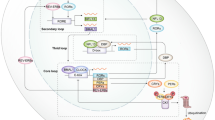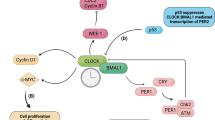Abstract
The Period (Per) genes are key circadian rhythm regulators in mammals. Expression of the mouse Per (mPer) genes have diurnal pattern in the suprachiamstic nuclei and in peripheral tissues. Genetic ablation mPER1 and mPER2 function results in a complete loss of circadian rhythm control based on wheel running activity in mice. In addition, these animals also display apparent premature aging and significant increase in neoplastic and hyperplastic phenotypes. When challenged by γ-radiation, mPer2 deficient mice response by rapid hair graying, are deficient in p53-mediated apoptosis in thymocytes and have robust tumor occurrences. Our studies have demonstrated that the circadian clock function is very important for cell cycle, DNA damage response and tumor suppression in vivo. Temporal expression of genes involved in cell cycle regulation and tumor suppression, such as c-Myc, Cyclin D1, Cyclin A, Mdm-2 and Gadd45α is deregulated in mPer2 mutant mice. In addition, genetic studies have demonstrated that many key regulators of cell cycle and growth control are also important circadian clock regulators confirming the critical role of circadian function in organismal homeostasis. Recently studies of human breast and endometrial cancers revealed that the loss and deregulation of PERIOD proteins is common in the tumor cells.




Similar content being viewed by others
References
Sun ZS, Albrecht U, Zhuchenko O, Bailey J, Eichele G, Lee CC (1997) RIGUI, a putative mammalian ortholog of the Drosophila period gene. Cell 90:1003–1011
Albrecht U, Sun ZS, Eichele G, Lee CC (1997) A differential response of two putative mammalian circadian regulators, mper1 and mper2, to light. Cell 91:1055–1064
Zylka MJ, Shearman LP, Weaver DR, Reppert SM (1998) Three period homologs in mammals: differential light responses in the suprachiasmatic circadian clock and oscillating transcripts outside of brain. Neuron 20:1103–1110
Zheng B, Larkin DW, Albrecht U, etal. (1999) The mPer2 gene encodes a functional component of the mammalian circadian clock. Nature 400:169–173
Balsalobre A, Damiola F, Schibler U (1998) A serum shock induces circadian gene expression in mammalian tissue culture cells. Cell 93:929–937
Zheng B, Albrecht U, Kaasik K, etal. (2001) Nonredundant roles of the mPer1 and mPer2 genes in the mammalian circadian clock. Cell 105:683–694
Toh KL, Jones CR, He Y, Eide EJ, Hinz WA, Virshup DM, Ptacek LJ, Fu YH (2001) An hPer2 phosphorylation site mutation in familial advanced sleep phase syndrome. Science 291:1040–1043
Lee C, Weaver DR, Reppert SM (2004) Direct association between mouse PERIOD and CKIepsilon is critical for a functioning circadian clock. Mol Cell Biol 24:584–594
Shiromani PJ, Xu M, Winston EM, Shiromani SN, Gerashchenko D, Weaver DR (2004) Sleep rhythmicity and homeostasis in mice with targeted disruption of mPeriod genes. Am J Physiol Regul Integr Comp Physiol 287:47–57
Fu L, Pelicano H, Liu J, Huang P, Lee CC (2002) The circadian gene Period2 plays an important role in tumor suppression and DNA damage response in vivo. Cell 111:41–50
Barlow C, Eckhaus MA, Schaffer AA, Wynshaw-Boris A (1999) Atm haploinsufficiency results in increased sensitivity to sublethal doses of ionizing radiation in mice. Nat Genet 21:359–360
Kawara S, Mydlarski R, Mamelak AJ, etal. (2002) Low-dose ultraviolet B rays alter the mRNA expression of the circadian clock genes in cultured human keratinocytes.J Invest Dermatol 119:1220–1223
Evan GI, Vousden KH (2001) Proliferation, cell cycle and apoptosis in cancer. Nature 411:342–348
Jamerson MH, Johnson MD, Dickson RB (2004) Of mice and Myc: c-Myc and mammary tumorigenesis. J Mammary Gland Biol Neoplasia 9:27–37
Tao H, Umek RM (1999) Reciprocal regulation of gadd45 by C/EBPalpha and c-Myc DNA. Cell Biol 18:75–84
Matsuo T, Yamaguchi S, Mitsui S, Emi A, Shimoda F, Okamura H (2003) Control mechanism of the circadian clock for timing of cell division in vivo. Science 302:255–259
Chen ST, Choo KB, Hou MF, Yeh KT, Kuo SJ, Chang JG (2005) Deregulated expression of the PER1, PER2 and PER3 genes in breast cancers. Carcinogenesis. 2005 Mar 24; [Epub ahead of print]
Yeh KT, Yang MY, Liu TC, etal. (2005) Abnormal expression of period 1 (PER1) in endometrial carcinoma. J Pathol 206:111–120
Zhu Y, Brown HN, Zhang Y, Stevens RG, Zheng T (2005) Period3 structural variation:a circadian biomarker associated with breast cancer in young women. Cancer Epidemiol Biomarkers Prev 14:268–270
Stevens RG (2005) Circadian disruption and breast cancer: from melatonin to clock genes. Epidemiology 16:254–258
Vogelstein B, Lane D, Levine AJ (2000) Surfing the p53 network. Nature 408:307–310
Xu X, Landesman-Bollag E, Channavajhala PL, Seldin DC (1999) Murine protein kinase CK2: gene and oncogene. Mol Cell Biochem 191:65–74
Yang Y, Cheng P, Liu Y (2002) Regulation of the Neurospora circadian clock by casein kinase II. Genes Dev 16:994–1006
Lin JM, Kilman VL, Keegan K, Paddock B, Emery-Le M, Rosbash M, Allada R (2002) A role for casein kinase 2alpha in the Drosophila circadian clock. Nature 420:816–820
Buchou T, Vernet M, Blond O, etal. (2003) Disruption of the regulatory beta subunit of protein kinase CK2 in mice leads to a cell-autonomous defect and early embryonic lethality. Mol Cell Biol 23:908–915
Lowrey PL, Shimomura K, Antoch MP, etal. (2000) Positional syntenic cloning and functional characterization of the mammalian circadian mutation tau. Science 288:483–492
Harms E, Young MW, Saez L (2003) CK1 and GSK3 in the Drosophila and mammalian circadian clock. Novartis Found Symp 253:267–277
Gao ZH, Seeling JM, Hill V, Yochum A, Virshup DM (2002) Casein kinase I phosphorylates and destabilizes the beta-catenin degradation complex. Proc Natl Acad Sci USA 99:1182–1187
Clevers H (2004) Wnt breakers in colon cancer. Cancer Cell 5:5–6
Sathyanarayanan S, Zheng X, Xiao R, Sehgal A (2004) Posttranslational regulation of Drosophila PERIOD protein by protein phosphatase 2A. Cell 116:603–615
Yang Y, He Q, Cheng P, Wrage P, Yarden O, Liu Y (2004) Distinct roles for PP1 and PP2A in the Neurospora circadian clock. Genes Dev 18:255–260
Yeh E, Cunningham M, Arnold H, etal. (2004) A signalling pathway controlling c-Myc degradation that impacts oncogenic transformation of human cells. Nat Cell Biol 6:308–318
ildesheim J, Belova GI, Tyner SD, Zhou X, Vardanian L, Fornace AJ Jr (2004) Gadd45 regulates matrix metalloproteinases by suppressing DeltaNp63alpha and beta-catenin via p38 MAP kinase and APC complex activation. Oncogene 23:1829–1837
Acknowledgement
I would like to thank Dr. J. Lever for comments on this manuscript. This work is supported in part by funding from NIH.
Author information
Authors and Affiliations
Corresponding author
Rights and permissions
About this article
Cite this article
Lee, C.C. Tumor Suppression by the Mammalian Period Genes. Cancer Causes Control 17, 525–530 (2006). https://doi.org/10.1007/s10552-005-9003-8
Issue Date:
DOI: https://doi.org/10.1007/s10552-005-9003-8




